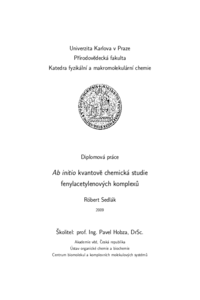Ab initio quantum chemical investigation of phenylacetylene complexes
Ab initio kvantově chemická studie fenylacetylenových komplexů
rigorous thesis (RECOGNIZED)

Reason for restricted acccess:
The annexes of the thesis or its part are inaccessible in accordance with article 18a (7) of The Code of Study and Examination in conjunction with Article 9 of the Rector’s Directive No. 6/2010.
View/
Permanent link
http://hdl.handle.net/20.500.11956/47642Identifiers
Study Information System: 111898
Collections
- Kvalifikační práce [20326]
Author
Faculty / Institute
Faculty of Science
Discipline
Modelling of Chemical Properties of Nano- and Biostructures
Department
Department of Physical and Macromolecular Chemistry
Date of defense
20. 9. 2011
Publisher
Univerzita Karlova, Přírodovědecká fakultaLanguage
English
Grade
Recognized
Cieľom diplomovej práce je kvantovo-chemicky vyšetriť nekovaletne: vodíkovo viazané komplexy fenyacetylénu s roznymi molekulami ako napr: voda, amoniak, metanol, metylamín, borántrimetylamín. Hlavne vysvetlit metylom indukovanú zmenu štruktúrneho motívu. V prvej kapitole sú bližsie popísané vlastnosti fenylacetylénu, hlavne jeho rozmanitosť z hľadiska možných vazbových motívov v roznych komplexoch. Druhá kapitola pojednáva o experimentálnom pozadí práce, cituje použité spektrálne metódy. Popisuje interpretáciu experimentálne pozorovaných spektier. V tretej kapitole je vysvetlená metodológia hľadania lokálnych minim na povrchu potenciálnej energie. Predstavený je koncept prechodu od interakčnej energie ku voľnej Gibbsovej energii. Kapitola obsahuje podrobný popis niektorých použitých metód, napr.: DFT-SAPT. Záverečná kapitola prezentuje získané výsledky a interpretuje prepojenie medzi experimentálnymi a teoretickými výsledkami, čo vedie k lepšiemu pochopeniu experimentálne pozorovaných skutočností.
The thesis is focused on quantum-chemistry investigation of non-covalent: hydrogen bonded complexes of phenylacetylene with various molecules: water, ammonia, methanol, methylamine, borane trimethylamine. Mainly explain methyl induced switching of the binding motif. First chapter describes properties of the phenylacetylene molecule, mainly its multifunctionality according to present binding motifs in different complexes. Chapter number two treats the experimental background of the thesis, cite used spectroscopic methods. Interpretation of experimentaly observed spectra is also presented. Third chapter shows metodology used to find local minimas at potential energy surface. Transition from interaction energy to Gibbs free energy is also presented. Chapter also include proper describtion of some of the computational methods for example: DFT-SAPT. Last chapter presents results and interprets connection between theory and experiment, which leads to better understanding of observed phenomena.
